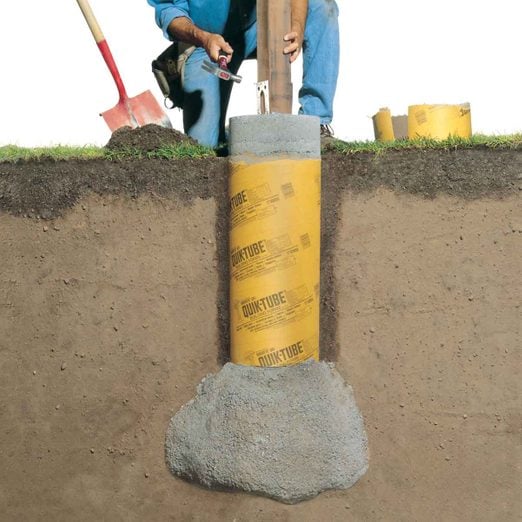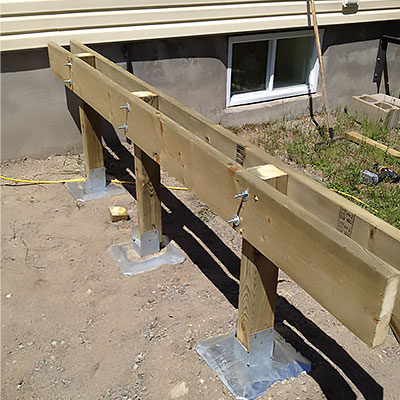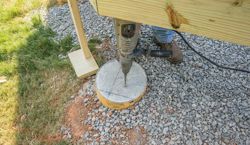Safeguard Foundations, Lasting Impacts: Grasping the Art of Deck Footings Installment
Expert Tips for Setting Up Deck Footings to Support Your Outdoor Area
When it pertains to building a deck, one of the most crucial elements to think about is the setup of appropriate footings. These grounds are the structure whereupon your exterior space will rest, offering security and support for years ahead. However what exactly does it take to mount deck grounds correctly? In this discussion, we will certainly explore professional ideas and strategies that can help make sure a effective and sturdy deck installation. From selecting the right type of grounds to preventing typical blunders, we will certainly offer you with the knowledge and understandings you need to confidently start your deck-building journey. Allow's dive right in and uncover the secret to a strong and resilient outside area.
Relevance of Appropriate Deck Grounds
Correct deck footings are necessary for making certain the stability and durability of your exterior space. Without strong and correctly installed grounds, your deck might come to be unstable, leading to security dangers and expensive repairs.

In enhancement to security, correct deck grounds also add to the longevity of your exterior room (Deck Footings). Grounds that are created and constructed to hold up against the aspects and dirt conditions in your location will assist avoid the deck from resolving or shifting gradually. By guaranteeing the footings are appropriately sized and set up, you can decrease the risk of damages to the deck structure, extending its life expectancy and reducing the need for pricey repair work or substitutes

Choosing the Right Sort Of Footings
When selecting the ideal kind of footings for your deck, it is very important to consider variables such as dirt problems, neighborhood structure codes, and the general layout of your outside space. The sort of footing you pick will play a vital duty in making sure the security and durability of your deck.
One common type of footing is the concrete footing. Concrete footings are ideal for a lot of soil problems and offer exceptional assistance for decks.
In many cases, you might require to utilize specialized footings, such as stack footings or deep structures, if you are developing a multi-level or large deck. These grounds are made to distribute the weight of the deck over a larger location, making sure stability and stopping settling or sinking.
Prior to picking a type of footing, it is vital to get in touch with regional building ordinance and guidelines to make certain conformity. Additionally, consider the style and meant use of your outdoor space. Elements such as the size, form, and load-bearing needs of your deck will influence the kind of footing that is most ideal.
Preparing the Ground for Footing Installation
To correctly prepare the ground for footing installation, it is vital to analyze the soil problems and take required actions to make sure stability and resilience of the deck. The initial step is to dig deep into the location where the footings will be set up.
When the area has been dug deep into, the next step is to small the soil. This can be done using a plate compactor or by using a hand tamper. Compacting the dirt helps to get rid of any gaps or air pockets, which can cause working out and instability over time.
After compacting the dirt, it is essential to lay a layer of crushed rock or smashed stone at the end of the excavation. This will certainly provide drain and assistance to prevent water from merging around the grounds, which can lead to erosion and instability.
Step-by-Step Guide to Setting Up Deck Footings
After correctly preparing the ground for footing installation, the following action is to start the process of setting up deck grounds. This detailed guide will offer you with a clear understanding of just how to install deck grounds for your outside room.
Identify the place: Beginning by noting the settings of the deck grounds using risks and string. Make sure that the locations line up with the design and format of your deck.
Dig the openings: Use a post hole miner or an auger to dig the openings for the grounds. The depth and size of the holes need to remain in conformity with local building regulations and the specific demands directory of your deck design.
Degree the holes: Utilize a degree to make certain that the openings are dug to the correct depth and are level with each various other. (Deck Footings)
Include crushed rock: Area a layer of crushed rock at the end of each hole to boost drainage and avoid the wood from decaying.
Insert the grounds: Put the footings right into the holes, ensuring they are degree and plumb. Use a degree and a measuring tape to make sure accuracy.
Secure the footings: Put concrete right into the holes around the footings, loading them to the top. Make use of a message degree to make certain the footings stay degree as the concrete collections.
Enable time for treating: Allow the concrete remedy according to the maker's directions before proceeding with the deck building and construction.
Common Blunders to Prevent Throughout Footing Installment
One important element to take into consideration during the setup of deck footings is preventing usual blunders that can compromise the security and longevity of your outdoor space. While deck footings may look like a simple and uncomplicated component of the building process, neglecting certain variables can bring about pricey repair work and prospective safety dangers down the line.

Furthermore, neglecting to mount appropriate drain procedures can trigger water to collect around the grounds, bring about rot, decay, and the eventual weakening of the deck's structure. Furthermore, making use of the incorrect this post kind of footing product or failing to effectively safeguard the grounds can endanger their architectural stability.
To avoid these blunders, it is important to talk to an expert or adhere to industry standards to guarantee proper footing installation. By doing so, you can guarantee the stability and long life of your outdoor space, giving a delightful and secure environment for many years to come.
Conclusion
Finally, installing appropriate deck grounds is important for the security and long life of your exterior space. By picking the right sort of grounds and appropriately preparing the ground, you can ensure a solid structure for your deck. Following a detailed overview and avoiding common errors throughout footing installation will certainly even more improve the resilience and safety go to my blog and security of your deck.
Correct deck grounds are vital for making sure the security and durability of your outside area. The footings offer as a connection between the ground and the deck, enabling the weight of the deck and its passengers to be dispersed evenly right into the soil.One usual type of ground is the concrete ground. Place the footings: Position the footings into the openings, making sure they are degree and plumb. Secure the footings: Pour concrete right into the holes around the grounds, loading them to the top.